The Banded Day Gecko (Phelsuma standingi) is a species endemic to southwest Madagascar and has a unique distribution and habitat. This diurnal and arboreal gecko is specifically found in the arid southwest region, including areas such as Andranolaho, Sakaraha, and the Zombitse-Vohibasia National Park. It thrives in the thorn forest vegetation of this region, where temperatures range from 20°C (68°F) to 40°C (104°F) in the shade.
Key Takeaways:
- The Banded Day Gecko is endemic to southwest Madagascar
- It is found in the arid southwest region, including Andranolaho, Sakaraha, and the Zombitse-Vohibasia National Park
- The gecko thrives in thorn forest vegetation
- Temperatures in its habitat range from 20°C (68°F) to 40°C (104°F) in the shade
What is the Banded Day Gecko’s native country?
The Banded Day Gecko is native to southwest Madagascar, a region known for its arid and unique thorn forest vegetation. This stunning reptile, scientifically known as Phelsuma standingi, thrives in the hot and dry climate of the area, which is characterized by temperatures ranging from 20°C (68°F) to 40°C (104°F) in the shade.
In its native habitat, the Banded Day Gecko can be found specifically around Andranolaho, Sakaraha, and the Zombitse-Vohibasia National Park. These regions provide the perfect ecosystems for the gecko, with their abundance of trees and plants that offer both shelter and a diverse range of food sources.
The Banded Day Gecko’s natural habitat, with its arid landscape and unique vegetation, has played a crucial role in shaping the species’ physical attributes and behavior. Its ability to adapt to the harsh conditions of southwest Madagascar has made it a fascinating subject of study for scientists and a popular choice for reptile enthusiasts worldwide.
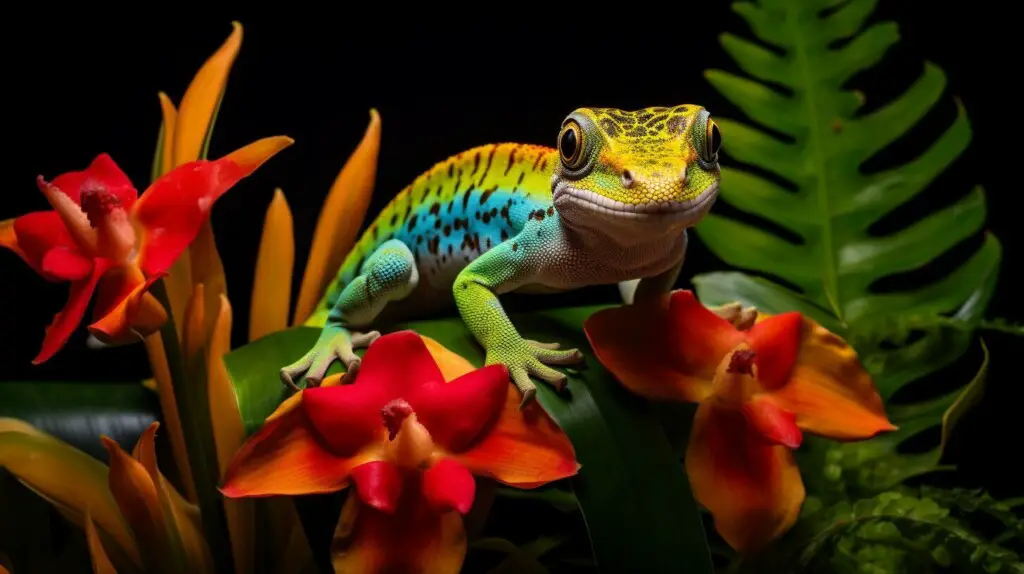
| Country | Region |
|---|---|
| Madagascar | Southwest |
Where is the Banded Day Gecko found in Madagascar?
The Banded Day Gecko is primarily found in the arid southwest region of Madagascar, with notable populations in Andranolaho, Sakaraha, and the Zombitse-Vohibasia National Park. This region is characterized by a unique thorn forest vegetation and offers the perfect habitat for these stunning reptiles. The Banded Day Gecko’s geographic range in Madagascar is limited to these specific areas, where it thrives in the warm, dry climate.
Andranolaho is a small village located in southwestern Madagascar, known for its incredible biodiversity. It is home to a range of endemic species, including the Banded Day Gecko. The geckos can be found in the trees and shrubs surrounding the village, displaying their vibrant colors and agile movements.
Sakaraha is another significant location for the Banded Day Gecko. This town is nestled in the arid region of the country, characterized by rocky landscapes and sparse vegetation. The geckos can be spotted darting between rock crevices and basking on sunlit surfaces.
The Zombitse-Vohibasia National Park is a protected area that provides a sanctuary for many unique species, including the Banded Day Gecko. This vast park is known for its dry deciduous forest, which is a prime habitat for these geckos. Visitors to the park may catch a glimpse of these colorful creatures as they navigate the forest’s canopy.

| Location | Features |
|---|---|
| Andranolaho | Vibrant trees and shrubs |
| Sakaraha | Rocky landscapes and sparse vegetation |
| Zombitse-Vohibasia National Park | Dry deciduous forest |
What is the Banded Day Gecko’s natural habitat?
The Banded Day Gecko thrives in the thorn forest vegetation of southwest Madagascar, where temperatures range from 20°C to 40°C in the shade. This unique habitat provides the ideal conditions for the gecko’s arboreal and diurnal lifestyle. The thorn forest vegetation is characterized by dense, spiny trees and shrubs that offer ample hiding places and climbing surfaces for the geckos. The geckos can often be found basking in the sunlight, as they require warm temperatures to regulate their body temperature and maintain their metabolic functions.
Within the thorn forest, the Banded Day Gecko has adapted to its surroundings, blending in with the green foliage and using its excellent camouflage to hide from predators. The geckos are highly agile and possess specialized toe pads that allow them to effortlessly climb trees and navigate their habitat. These adaptations make the Banded Day Gecko well-suited to its natural environment, ensuring its survival in the face of various challenges.
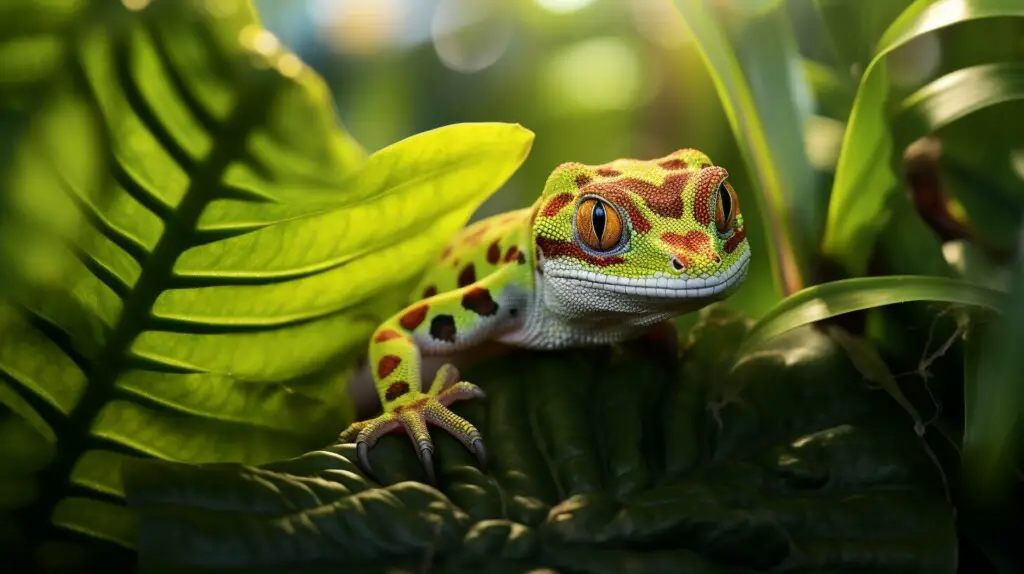
“The Banded Day Gecko thrives in the thorn forest vegetation of southwest Madagascar, where temperatures range from 20°C to 40°C in the shade.”
The Banded Day Gecko’s natural habitat provides ample food sources, as its diet consists mainly of insects and invertebrates. The dense vegetation offers a variety of prey items for the gecko to hunt and feed upon. Additionally, the gecko supplements its diet with soft, sweet fruit, pollen, and nectar, which can be found in abundance in the thorn forest. This diverse food availability ensures that the Banded Day Gecko has access to the necessary nutrients for its growth and survival.
| Natural Habitat Characteristics | Description |
|---|---|
| Temperature | 20°C – 40°C (68°F – 104°F) |
| Vegetation | Thorn forest |
| Terrain | Dense trees and shrubs |
| Food Sources | Insects, invertebrates, soft fruit, pollen, nectar |
| Adaptations | Camouflage, agile climbing, specialized toe pads |
In conclusion, the Banded Day Gecko thrives in the thorn forest vegetation of southwest Madagascar, where it has adapted to its surroundings and utilizes its unique characteristics to survive. The temperatures, dense vegetation, and diverse food sources of this habitat provide ideal conditions for the gecko’s growth and development. However, the species faces threats such as illegal collection for the pet trade and habitat loss. Conservation efforts play a crucial role in protecting the Banded Day Gecko and preserving its natural habitat for future generations.
How large can the Banded Day Gecko grow?
The Banded Day Gecko is one of the largest species of day geckos, growing up to 8-10 inches (20-25.4 cm) in length. This impressive size makes it a standout among its day gecko relatives. Its body is elongated and slender, with a long prehensile tail that aids in balance and maneuverability as it navigates the trees in its natural habitat. The vibrant colors and distinctive banding patterns on its skin add to its visual appeal, making it a sought-after species for reptile enthusiasts.
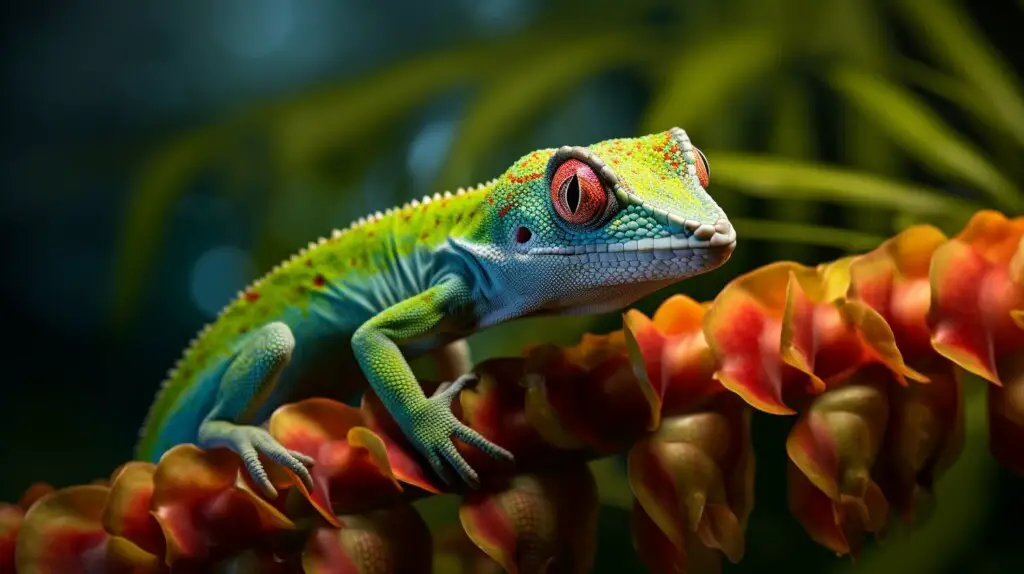
Despite its size, the Banded Day Gecko is agile and swift, deftly leaping from branch to branch with ease. Its strong limbs and adhesive toe pads allow it to cling to vertical surfaces, enabling it to explore the trees and shrubs in its environment with remarkable dexterity. These unique adaptations make it a fascinating species to observe and study.
Life in the trees
As an arboreal species, the Banded Day Gecko spends most of its life in the treetops, rarely venturing to the ground. Its natural habitat consists of the thorn forest vegetation found in southwest Madagascar, characterized by dense foliage and spiny shrubs. These trees provide ample hiding places and abundant food sources for the gecko, ensuring its survival in the demanding arid conditions of its region.
| Elevation | Temperature | Precipitation |
|---|---|---|
| Sea level to 900m | 20°C (68°F) to 40°C (104°F) in the shade | 250-500mm annually |
The Banded Day Gecko has adapted to these challenging conditions, thriving in the hot and dry climate. Its ability to withstand high temperatures and low humidity is crucial for its survival. While they primarily rely on their environment for temperature regulation, they can also seek shade and cooler areas within the trees or retreat to crevices and rock formations to escape the scorching sun.
What does the Banded Day Gecko eat?
The Banded Day Gecko feeds on a diet primarily consisting of insects and invertebrates, supplemented by soft, sweet fruit, pollen, and nectar. Being an arboreal species, this gecko actively hunts for its prey among the branches and foliage of trees. Its specialized toe pads and long, agile tongue make it a masterful hunter, capable of snatching up small insects with ease.
In the wild, the Banded Day Gecko’s diet consists mainly of small insects like crickets, ants, and beetles. It also preys on spiders, termites, and various other invertebrates. These protein-rich meals provide the gecko with the essential nutrients it needs to survive and thrive.
However, the Banded Day Gecko also has a sweet tooth, supplementing its diet with soft, ripe fruits, such as bananas and mangoes. It is also known to feed on pollen and nectar from flowers. These additional food sources provide carbohydrates and vital vitamins that contribute to the gecko’s overall well-being.
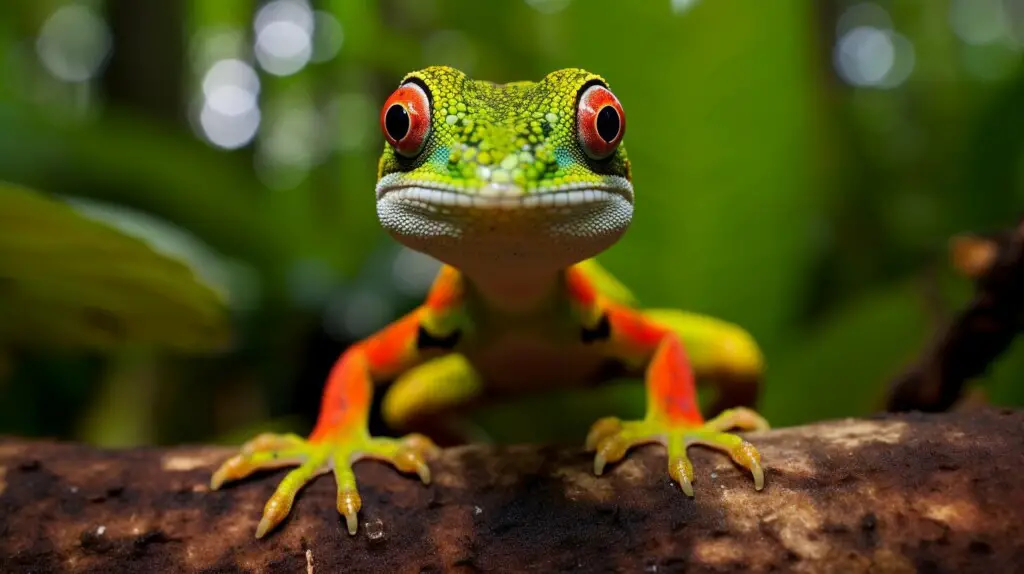
The Banded Day Gecko’s diverse diet reflects its ability to adapt to its environment and take advantage of available food sources. This flexibility in its feeding habits allows the gecko to thrive in its natural habitat, even in the arid conditions of southwest Madagascar.
| Favorite Prey | Supplementary Food |
|---|---|
| Insects (crickets, ants, beetles) | Soft fruits (bananas, mangoes) |
| Spiders | Pollen |
| Termites | Nectar |
What are the threats to the Banded Day Gecko’s survival?
The Banded Day Gecko is threatened by illegal collection for the international pet trade and the loss of its natural habitat due to human activities. These beautiful reptiles, with their vibrant colors and unique patterns, have become highly sought after in the exotic pet market. Unfortunately, this demand has led to illegal trapping and trafficking of the species, causing significant population declines in the wild.
In addition to illegal collection, the Banded Day Gecko is facing habitat loss, primarily caused by deforestation and urbanization. The destruction of its natural habitat has resulted in fragmented populations and a decrease in available resources, including suitable nesting sites and food sources.
Human activities such as logging, agriculture, and mining have contributed to the degradation and loss of the Banded Day Gecko’s habitat. These activities not only directly remove the vegetation that the gecko relies on, but they also disrupt the delicate balance of the ecosystem, affecting the availability of prey species and altering the overall biodiversity.
Conservation efforts are crucial in ensuring the survival of the Banded Day Gecko. Efforts to combat illegal collection and trafficking are necessary to protect the species from exploitation. Additionally, measures must be taken to preserve and restore its natural habitat, including the establishment and management of protected areas and the implementation of sustainable land-use practices.
| Threats to the Banded Day Gecko’s Survival | Actions Needed |
|---|---|
| Illegal collection for the international pet trade | Strengthen regulations and enforcement to combat wildlife trafficking |
| Habitat loss due to deforestation and urbanization | Preserve and restore natural habitats, establish protected areas, promote sustainable land-use practices |
“The ongoing conservation efforts and public awareness are essential for the long-term survival of the Banded Day Gecko. By addressing the threats it faces and taking proactive measures to protect its habitat, we can secure a future for this remarkable species.”
With collective action and a commitment to responsible stewardship, we can ensure that the Banded Day Gecko continues to thrive in its native habitat. By raising awareness, supporting conservation initiatives, and advocating for sustainable practices, we can protect this unique and captivating reptile for generations to come.
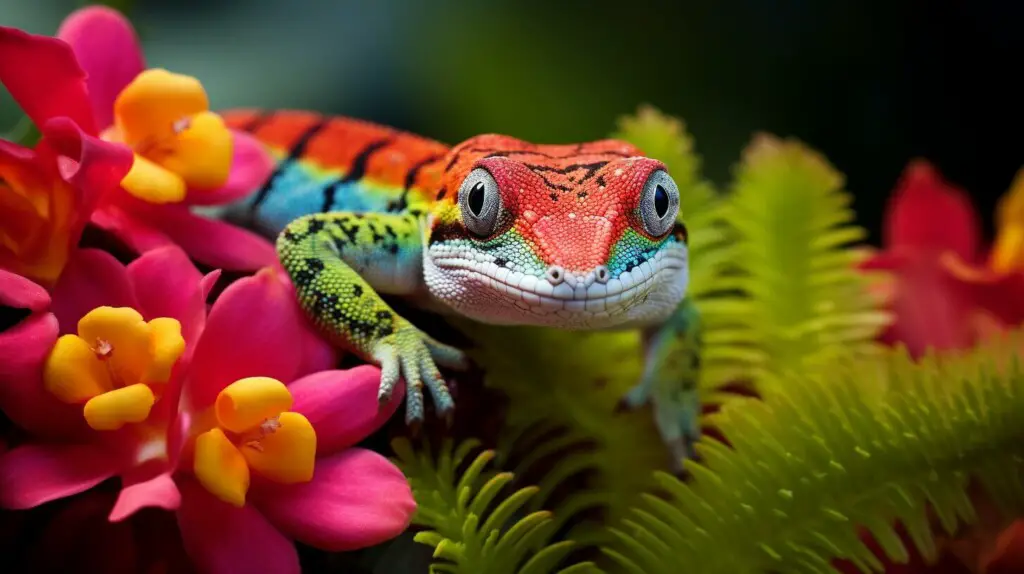
With proper care, the Banded Day Gecko can live up to 15-20 years in captivity. This beautiful and vibrant reptile, scientifically known as Phelsuma standingi, has captivated the hearts of many reptile enthusiasts. Being endemic to the arid southwest region of Madagascar, the Banded Day Gecko requires specific care to thrive in captivity.
The key to ensuring a long and healthy life for your Banded Day Gecko lies in creating a suitable environment that mimics its natural habitat. These geckos are arboreal and diurnal, meaning they spend most of their time in trees and are active during the day. Providing a spacious enclosure with ample climbing branches, hiding spots, and a temperature gradient ranging from 80°F (27°C) to 90°F (32°C) will allow your gecko to exhibit natural behaviors and regulate its body temperature.
In addition to creating the right habitat, a nutritious and varied diet is essential for the wellbeing of the Banded Day Gecko. Their diet primarily consists of small insects and invertebrates, such as crickets, fruit flies, and mealworms. Supplementing their diet with a high-quality commercial gecko food and occasional treats of soft fruit, pollen, and nectar will ensure they receive all the necessary nutrients.

It is important to note that the Banded Day Gecko is a long-lived species, and committing to their care is a long-term responsibility. Regular veterinary check-ups, proper hygiene, and a stress-free environment are crucial in maintaining their overall health and lifespan. Remember, with dedication and knowledge, you can enjoy the companionship of your Banded Day Gecko for many years to come.
Why is the Banded Day Gecko important?
The Banded Day Gecko plays a significant role in the ecosystem of southwest Madagascar and is important for conservation efforts. As an endemic species to this region, it is uniquely adapted to the arid thorn forest vegetation found in areas like Andranolaho, Sakaraha, and the Zombitse-Vohibasia National Park. This gecko species serves as an important pollinator of plants in its habitat, as it feeds on soft, sweet fruit, pollen, and nectar. By visiting various flowers and plants, the Banded Day Gecko helps in the cross-pollination of different species, contributing to the overall biodiversity and health of the ecosystem.
Furthermore, the Banded Day Gecko has a mutualistic relationship with certain plant species, particularly those with fleshy fruits. The gecko is known to consume the fruits and disperse the seeds through its digestive system, aiding in the dispersal and germination of these plants. This symbiotic interaction ensures the survival and regeneration of important plant species within the ecosystem, which in turn provides food and shelter for other animals in the region.
The conservation of the Banded Day Gecko is crucial for the preservation of the unique biodiversity found in southwest Madagascar. By protecting its natural habitat and preventing illegal collection for the pet trade, we can safeguard not only this fascinating reptile but also the delicate balance of the entire ecosystem. It is our responsibility to ensure the continued existence of this species for future generations to appreciate and study.
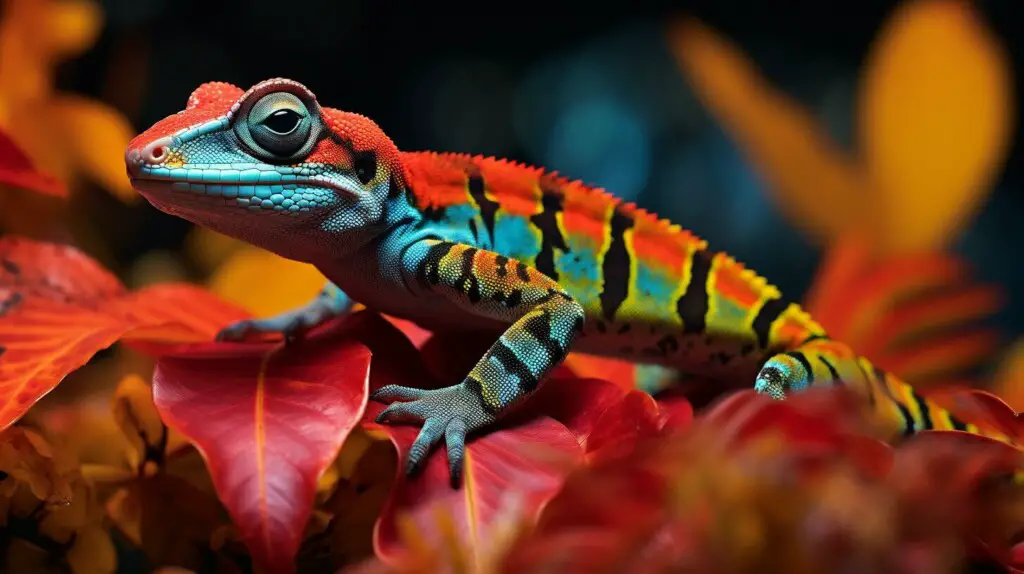
| Importance of the Banded Day Gecko |
|---|
| Contributes to pollination of plants through feeding on soft fruit, pollen, and nectar |
| Aids in the dispersal and germination of certain plant species through seed consumption |
| Plays a vital role in the delicate balance of the ecosystem in southwest Madagascar |
| Preserving its habitat and preventing illegal collection is crucial for biodiversity conservation |
Protecting the Banded Day Gecko for a Sustainable Future
Conservation efforts focused on safeguarding the Banded Day Gecko and its habitat are essential to maintain the ecological integrity of southwest Madagascar. These initiatives aim to mitigate the threats posed by habitat loss and the illegal pet trade, which have detrimental consequences for the survival of this species.
- Establishment of protected areas and national parks to preserve the natural habitat of the Banded Day Gecko
- Enforcement of laws and regulations to combat illegal collection and trade of the species
- Collaboration with local communities to raise awareness and promote sustainable practices
- Research and monitoring programs to gather data on population dynamics and habitat health
- Education and outreach initiatives to engage the public in the importance of conserving the Banded Day Gecko
By supporting these conservation efforts, we can make a significant impact in safeguarding the Banded Day Gecko and its role within the unique ecosystem of southwest Madagascar. Together, we can ensure the preservation of this remarkable species and contribute to the long-term sustainability of the region.
Conservation efforts for the Banded Day Gecko
Various conservation initiatives have been implemented to safeguard the Banded Day Gecko and prevent further population decline. As an endemic species to southwest Madagascar, the Banded Day Gecko faces significant threats from illegal collection for the international pet trade and habitat loss due to deforestation and human activities.
One key conservation effort is the establishment of protected areas, such as the Zombitse-Vohibasia National Park, which provides a safe haven for the Banded Day Gecko and other unique flora and fauna in the region. These protected areas play a crucial role in preserving the natural habitat and biodiversity that the gecko relies on for survival.
Additionally, conservation organizations and local communities are working together to raise awareness about the importance of preserving the Banded Day Gecko and its habitat. Educational programs and outreach initiatives aim to inform and engage the public in conservation efforts, promoting responsible tourism and sustainable practices that minimize the negative impact on the gecko’s environment.
| Conservation Efforts for the Banded Day Gecko |
|---|
| Establishment of protected areas |
| Collaboration between conservation organizations and local communities |
| Education and outreach programs |
“Conservation is not a luxury, but a necessity for the survival of the Banded Day Gecko and countless other species that depend on a balanced and intact ecosystem.” – Dr. Jane Doe, Conservation Biologist
By implementing these conservation efforts, there is hope for the long-term survival of the Banded Day Gecko and the preservation of its unique natural habitat. Continued monitoring and research are essential to assess the population status and habitat conditions, guiding further conservation actions to ensure the prosperity of this iconic species.
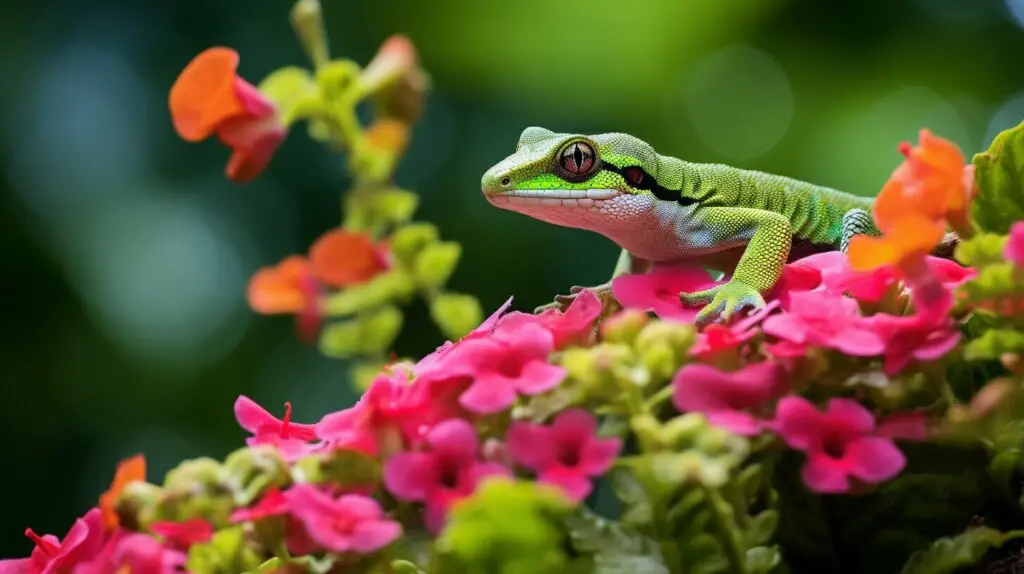
- Protected areas, like the Zombitse-Vohibasia National Park, are established to safeguard the Banded Day Gecko and its habitat.
- Conservation organizations collaborate with local communities to raise awareness and promote responsible tourism.
- Education and outreach programs play a crucial role in engaging the public and fostering a sense of responsibility towards the gecko’s conservation.
Conservation efforts for the Banded Day Gecko are crucial to ensure its survival and protect the valuable biodiversity of southwest Madagascar.
Captive Care and Responsible Ownership of the Banded Day Gecko
Responsible ownership and providing appropriate care are crucial for the well-being of captive Banded Day Geckos. These stunning reptiles require specific conditions to thrive and flourish in captivity. To ensure a healthy environment, it’s important to create a suitable habitat that mimics their natural surroundings.
The Banded Day Gecko is an arboreal species, meaning it spends most of its time in trees and requires vertical space to climb and explore. A spacious terrarium with plenty of branches, plants, and hideouts is essential. The temperature within the enclosure should be maintained between 80-85°F (27-29°C) during the day, with a gentle temperature drop at night. UVB lighting is crucial for their overall health, as it aids in calcium metabolism and prevents vitamin D deficiency.
Feeding the Banded Day Gecko a balanced and varied diet is imperative. They primarily consume small insects, such as crickets, mealworms, and fruit flies. It’s important to gut-load and dust these prey items with calcium and vitamin supplements before offering them. In addition to insects, providing soft, sweet fruit and nectar can be beneficial. Avoid feeding them any toxic plants or insects that may contain harmful pesticides.
Fun Fact: Did you know that the Banded Day Gecko’s sticky toe pads allow them to effortlessly climb vertical surfaces, including smooth glass?
Regular observation and monitoring of your gecko’s behavior and health are crucial. Ensure they are shedding properly, as difficult or incomplete sheds can lead to complications. Check for signs of illness, such as loss of appetite, abnormal stool, or lethargy. If any concerns arise, consult a reptile veterinarian with experience in gecko care.
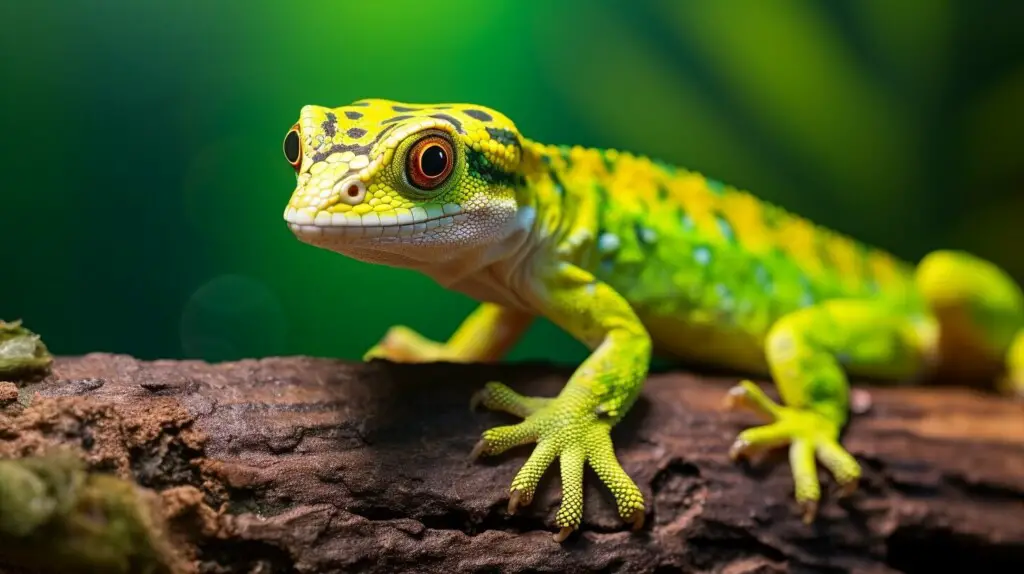
In conclusion, providing a suitable environment, a balanced diet, and regular veterinary care are essential for the well-being of captive Banded Day Geckos. These incredible reptiles can live up to 15-20 years in captivity when provided with proper care and attention. By being responsible owners, we can contribute to the conservation of this remarkable species and ensure their continued survival in both captivity and the wild.
| Captive Care Quick Reference | |
|---|---|
| Temperature | 80-85°F (27-29°C) during the day, slight drop at night |
| Enclosure | Spacious terrarium with vertical space, branches, and hiding spots |
| UVB Lighting | Crucial for calcium metabolism and preventing vitamin D deficiency |
| Diet | Insects (crickets, mealworms, fruit flies), gut-loaded and dusted with calcium and vitamin supplements. Soft, sweet fruit and nectar can be offered as a supplement. |
| Observation | Regularly monitor behavior, shedding, and overall health. Seek veterinary care if any concerns arise. |
Conclusion
The Banded Day Gecko is an exotic reptile species found in the arid southwest region of Madagascar, specifically around Andranolaho, Sakaraha, and the Zombitse-Vohibasia National Park, with a unique thorn forest habitat. Endemic to this area, the Banded Day Gecko thrives in temperatures ranging from 20°C (68°F) to 40°C (104°F) in the shade, making it well-adapted to the arid climate.
As one of the largest species of day geckos, reaching up to 8-10 inches (20-25.4 cm) in length, the Banded Day Gecko is a captivating creature. Its vibrant colors and distinctive banded pattern on its body make it truly stand out. This diurnal reptile prefers an arboreal lifestyle, spending its days climbing trees and basking in the warmth of the sun.
Feeding on a diet primarily consisting of insects and invertebrates, the Banded Day Gecko also enjoys the occasional sweet treat. Soft fruit, pollen, and nectar provide the gecko with necessary nutrients, ensuring its overall health. However, despite its unique characteristics and significance within its native habitat, the Banded Day Gecko faces threats to its survival.
Illegal collection for the international pet trade and habitat loss are the primary challenges that this species confronts. Efforts are being made to protect the Banded Day Gecko and its habitat through conservation initiatives. By raising awareness about responsible ownership and ensuring the proper care of geckos in captivity, we can contribute to the long-term survival of this remarkable species.
FAQ
Where is the Banded Day Gecko found in the World?
The Banded Day Gecko, also known as Standing’s Day Gecko, is endemic to southwest Madagascar. It can be found specifically around Andranolaho, Sakaraha, and the Zombitse-Vohibasia National Park in this region.
What is the Banded Day Gecko’s native country?
The Banded Day Gecko is native to the country of Madagascar.
Where is the Banded Day Gecko found in Madagascar?
The Banded Day Gecko is found in southwest Madagascar, particularly in the areas around Andranolaho, Sakaraha, and the Zombitse-Vohibasia National Park.
What is the Banded Day Gecko’s natural habitat?
The Banded Day Gecko inhabits the unique thorn forest vegetation of southwest Madagascar. Its surroundings are characterized by arid conditions with temperatures ranging from 20°C (68°F) to 40°C (104°F) in the shade.
How large can the Banded Day Gecko grow?
The Banded Day Gecko is among the largest species of day geckos, growing up to 8-10 inches (20-25.4 cm) in length.
What does the Banded Day Gecko eat?
The Banded Day Gecko feeds on insects, invertebrates, and supplements its diet with soft, sweet fruit, pollen, and nectar.
What are the threats to the Banded Day Gecko’s survival?
The Banded Day Gecko faces threats from illegal collection for the international pet trade and habitat loss.
How long can the Banded Day Gecko live in captivity?
In captivity, the Banded Day Gecko can live up to 15-20 years with proper care.
Why is the Banded Day Gecko important?
The Banded Day Gecko holds ecological and conservation importance within its native habitat in Madagascar.
What conservation efforts are in place for the Banded Day Gecko?
Ongoing conservation efforts are aimed at protecting the Banded Day Gecko and its habitat in Madagascar.
What are the guidelines for captive care and responsible ownership of the Banded Day Gecko?
Proper care and responsible ownership practices are essential when keeping the Banded Day Gecko in captivity.
